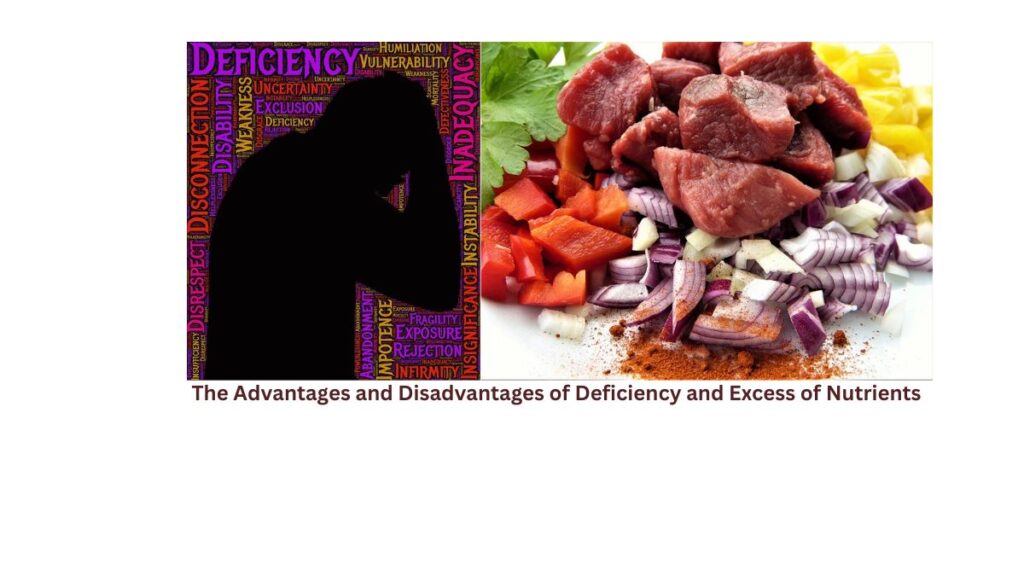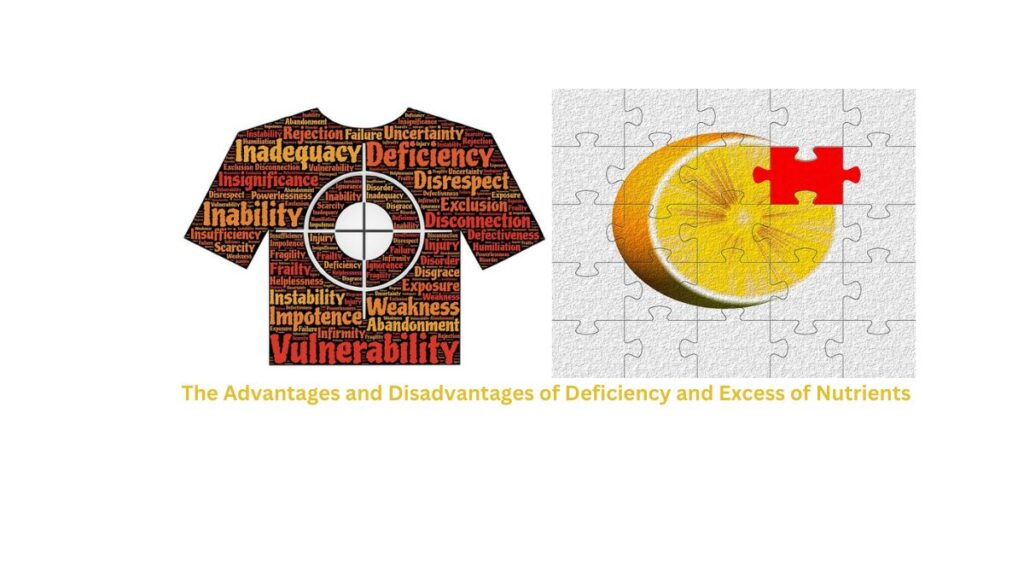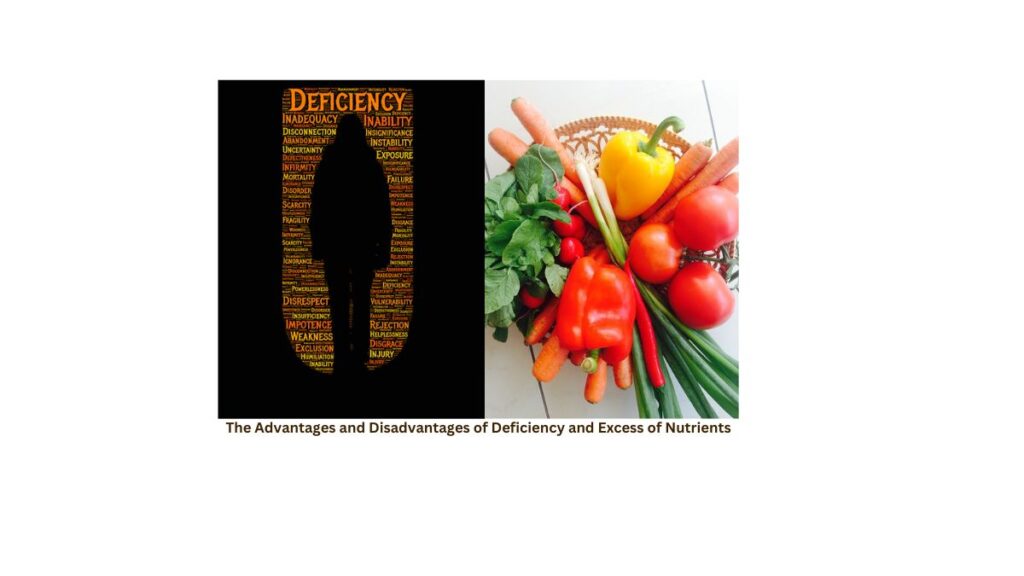Introduction: –

“Navigating Nutrient Balance: Exploring the Advantages and Disadvantages of Deficiency and Excess of Nutrients
In the realm of nutrition, finding the right balance of essential nutrients is key to maintaining optimal health and well-being. However, both deficiency and excess of nutrients can have significant impacts on the body, each carrying its own set of advantages and disadvantages. Let’s delve into the intricacies of nutrient balance and uncover the potential benefits and drawbacks of deficiencies and excesses.
The Advantages and Disadvantages of Deficiency and Excess of Nutrients
Advantages of Nutrient Deficiency:

- Increased Awareness: Experiencing a deficiency in a particular nutrient can heighten awareness of its importance in maintaining overall health. This heightened awareness may prompt individuals to pay closer attention to their diet and seek out sources of the deficient nutrient.
- Motivation for Dietary Improvement: Nutrient deficiencies can serve as a catalyst for dietary improvements, encouraging individuals to incorporate a wider variety of nutrient-rich foods into their diet to address deficiencies and promote overall health.
- Diagnostic Value: Identifying specific nutrient deficiencies can provide valuable insights into underlying health issues or dietary imbalances. This information can guide healthcare professionals in developing targeted interventions to address nutritional deficiencies and improve overall health outcomes.
Disadvantages of Nutrient Deficiency:
- Impaired Health: Nutrient deficiencies can lead to a range of adverse health effects, including weakened immune function, impaired cognitive function, decreased energy levels, and increased susceptibility to chronic diseases.
- Negative Impact on Growth and Development: Inadequate intake of essential nutrients during critical periods of growth and development, such as childhood and pregnancy, can have long-lasting consequences on physical and cognitive development.
- Increased Risk of Nutrient Interactions: Nutrient deficiencies can disrupt the delicate balance of nutrients within the body, potentially leading to imbalances or interactions that exacerbate existing health issues.
Advantages of Nutrient Excess:
- Support for Specialized Health Needs: In certain cases, such as during periods of increased physical activity, illness, or pregnancy, temporarily higher intakes of specific nutrients may be beneficial to support specialized health needs and promote optimal functioning.
- Potential for Therapeutic Use: Some nutrients, when consumed in higher than recommended amounts, may have therapeutic effects and be used to manage specific health conditions or support certain physiological processes.
- Buffer Against Deficiency: Maintaining higher-than-normal levels of certain nutrients can serve as a buffer against future deficiencies, particularly in populations at risk of inadequate intake due to dietary restrictions, food allergies, or other factors.
Disadvantages of Nutrient Excess:
- Toxicity and Adverse Effects: Excessive intake of certain nutrients, such as vitamins and minerals, can lead to toxicity and cause a range of adverse effects, including gastrointestinal distress, organ damage, and increased risk of chronic diseases.
- Interference with Nutrient Absorption: High intake of certain nutrients may interfere with the absorption or utilization of other nutrients, leading to imbalances and potential deficiencies.
- Financial Costs: Consuming excessive amounts of supplements or fortified foods to achieve high nutrient intake levels can be costly and may not provide additional health benefits beyond what is obtained from a balanced diet.
How can excessive nutrient application harm the environment?
Excessive nutrient application, particularly in the context of agriculture, can have significant detrimental effects on the environment. Here’s how:
- Water Pollution: Excess nutrients, such as nitrogen and phosphorus from fertilizers, can leach into groundwater or runoff into nearby water bodies like rivers, lakes, and oceans. This nutrient runoff leads to eutrophication, where excessive nutrients stimulate the rapid growth of algae and other aquatic plants. As these plants die and decompose, oxygen levels in the water decrease, leading to hypoxic or “dead” zones where aquatic life cannot survive.
- Soil Degradation: Overapplication of fertilizers can alter the soil’s chemical composition and pH balance, leading to soil acidification or alkalization. This disruption in soil health can degrade soil structure, reduce microbial diversity, and decrease soil fertility over time. Additionally, excessive nutrient levels can inhibit the uptake of other essential nutrients by plants, leading to nutrient imbalances and decreased crop yields.
- Air Pollution: Nitrogen fertilizers can also contribute to air pollution through processes like ammonia volatilization and nitrous oxide emissions. Ammonia released from fertilizers can react with other air pollutants to form particulate matter, which can degrade air quality and pose respiratory health risks. Nitrous oxide, a potent greenhouse gas, is released during microbial processes in soil and contributes to climate change and ozone depletion.
- Harm to Wildlife: Nutrient pollution can have detrimental effects on terrestrial and aquatic wildlife. In addition to disrupting aquatic ecosystems through eutrophication, excessive nutrients can harm fish, amphibians, and other aquatic organisms directly by causing oxygen depletion, altering habitat structure, and promoting harmful algal blooms. On land, nutrient runoff can lead to habitat degradation, loss of biodiversity, and negative impacts on wildlife populations.
- Loss of Biodiversity: Excessive nutrient application can promote the growth of fast-growing, opportunistic plant species at the expense of native vegetation. This can lead to shifts in plant communities, loss of habitat diversity, and increased vulnerability to invasive species. As biodiversity declines, ecosystems become less resilient to environmental stressors and less capable of providing essential ecosystem services.
To mitigate these environmental impacts, it’s essential for farmers and land managers to adopt sustainable nutrient management practices that minimize fertilizer runoff and maximize nutrient use efficiency. This includes precision agriculture techniques, such as soil testing, targeted fertilizer application, cover cropping, crop rotation, and agroforestry, as well as policy measures to regulate nutrient use and promote conservation practices. By prioritizing environmental stewardship and responsible nutrient management, we can safeguard ecosystems and protect the health and well-being of current and future generations.
How can we solve nutrient pollution?
Addressing nutrient pollution requires a multifaceted approach that involves changes in agricultural practices, land use management, wastewater treatment, and policy interventions. Here are several strategies to mitigate and solve nutrient pollution:

- Implement Best Management Practices (BMPs) in Agriculture: Encourage farmers to adopt BMPs such as precision agriculture techniques, conservation tillage, cover cropping, crop rotation, and nutrient management planning. These practices help optimize fertilizer use, reduce nutrient runoff, and enhance soil health and water quality.
- Promote Sustainable Livestock Management: Implement strategies to manage manure and nutrient waste from livestock operations, such as proper storage, composting, and application timing to minimize nutrient runoff. Encourage the use of rotational grazing and riparian buffers to reduce nutrient inputs into water bodies.
- Enhance Urban Stormwater Management: Implement green infrastructure solutions such as rain gardens, permeable pavement, and vegetated swales to capture and treat stormwater runoff before it reaches water bodies. Retrofitting existing infrastructure with green stormwater management practices can help reduce nutrient pollution in urban areas.
- Upgrade Wastewater Treatment Facilities: Upgrade and modernize wastewater treatment plants to incorporate advanced nutrient removal technologies such as biological nutrient removal (BNR) and enhanced nutrient removal (ENR). Implementing tertiary treatment processes can help remove excess nutrients from wastewater before discharge into water bodies.
- Encourage Nutrient Recovery and Recycling: Explore technologies for nutrient recovery from wastewater and agricultural runoff, such as nutrient extraction from sewage sludge and manure, and the production of nutrient-rich fertilizers or bioenergy. Promote the use of recycled nutrients in agriculture to reduce reliance on synthetic fertilizers.
- Educate and Engage Stakeholders: Increase public awareness and education about the sources and impacts of nutrient pollution, as well as the importance of nutrient stewardship and conservation practices. Engage stakeholders, including farmers, landowners, policymakers, and community members, in collaborative efforts to address nutrient pollution at the local, regional, and national levels.
- Implement Regulatory and Policy Measures: Enact and enforce regulations and policies to limit nutrient inputs into water bodies, such as nutrient management plans, buffer zone requirements, and nutrient discharge limits for point sources. Provide financial incentives, technical assistance, and cost-share programs to support compliance with nutrient management regulations.
- Promote Cross-Sector Collaboration: Foster collaboration among government agencies, academia, industry stakeholders, non-governmental organizations (NGOs), and community groups to develop integrated solutions for nutrient pollution management. Encourage interdisciplinary research and partnerships to address the complex challenges of nutrient pollution effectively.
By implementing these strategies in a coordinated and collaborative manner, we can work towards solving nutrient pollution and protecting the health of our ecosystems, communities, and future generations.
In conclusion,
While both nutrient deficiency and excess have their own set of advantages and disadvantages, achieving a balanced intake of essential nutrients is crucial for supporting overall health and well-being. Consulting with a healthcare professional or registered dietitian can help individuals develop personalized dietary strategies to optimize nutrient intake and minimize the risk of deficiencies or excesses.






